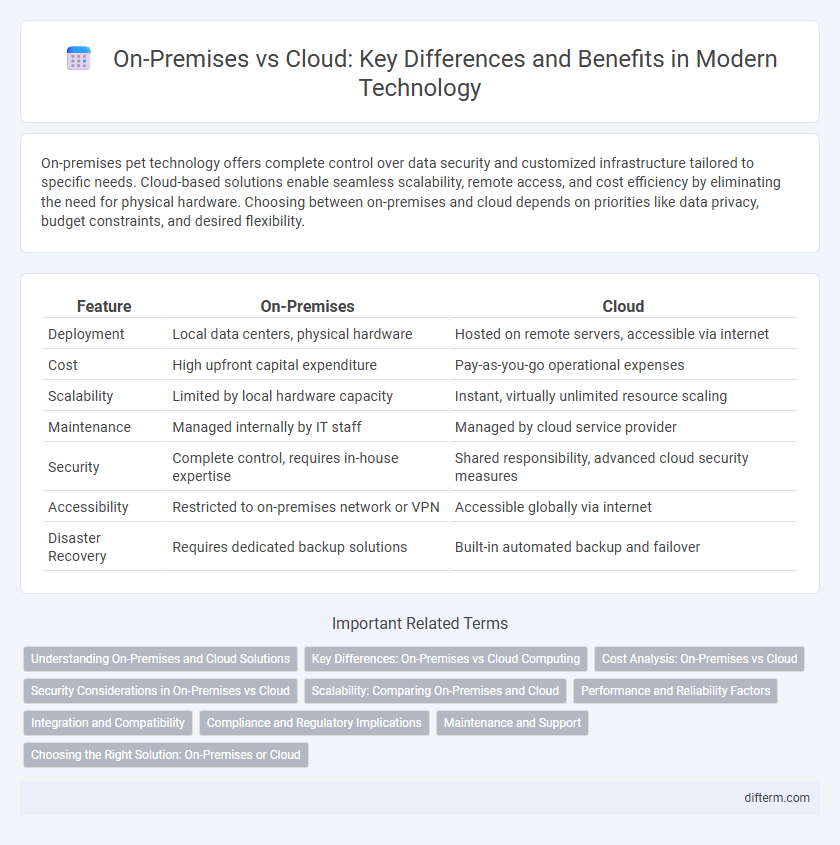On-premises pet technology offers complete control over data security and customized infrastructure tailored to specific needs. Cloud-based solutions enable seamless scalability, remote access, and cost efficiency by eliminating the need for physical hardware. Choosing between on-premises and cloud depends on priorities like data privacy, budget constraints, and desired flexibility.
Table of Comparison
| Feature | On-Premises | Cloud |
|---|---|---|
| Deployment | Local data centers, physical hardware | Hosted on remote servers, accessible via internet |
| Cost | High upfront capital expenditure | Pay-as-you-go operational expenses |
| Scalability | Limited by local hardware capacity | Instant, virtually unlimited resource scaling |
| Maintenance | Managed internally by IT staff | Managed by cloud service provider |
| Security | Complete control, requires in-house expertise | Shared responsibility, advanced cloud security measures |
| Accessibility | Restricted to on-premises network or VPN | Accessible globally via internet |
| Disaster Recovery | Requires dedicated backup solutions | Built-in automated backup and failover |
Understanding On-Premises and Cloud Solutions
On-premises solutions involve hosting and managing IT infrastructure within an organization's physical location, providing direct control over hardware, security, and data management. Cloud solutions leverage remote servers accessed via the internet, offering scalable resources, reduced capital expenditure, and flexible access to applications and storage. Evaluating on-premises versus cloud deployment hinges on factors like compliance requirements, workload types, and long-term cost efficiency.
Key Differences: On-Premises vs Cloud Computing
On-premises computing requires businesses to invest in physical servers and infrastructure, providing complete control over data security and customization. Cloud computing offers scalable resources and flexible pricing models, enabling rapid deployment and remote accessibility through internet-based services. Key differences include capital expenditure versus operational expenditure, maintenance responsibilities, and disaster recovery capabilities.
Cost Analysis: On-Premises vs Cloud
On-premises infrastructure demands significant upfront capital expenditures for hardware, software licenses, and physical space, leading to higher initial costs and ongoing maintenance expenses. Cloud computing offers a flexible, pay-as-you-go model that reduces capital investment, shifting expenses to operational costs based on usage, enhancing scalability and budget control. Cost analysis reveals cloud services often yield lower total cost of ownership over time due to reduced hardware depreciation and maintenance burdens, although large-scale or highly customized workloads may still favor on-premises implementations.
Security Considerations in On-Premises vs Cloud
On-premises environments provide organizations full control over physical security measures and data access protocols, allowing tailored security policies aligned with specific compliance requirements. Cloud providers implement robust, multi-layered security frameworks, including encryption, identity management, and continuous monitoring, yet shared responsibility models require clients to manage configuration and access controls vigilantly. Evaluating threat vectors and incident response capabilities is critical when choosing between on-premises infrastructure and cloud services to ensure alignment with organizational risk tolerance and regulatory mandates.
Scalability: Comparing On-Premises and Cloud
On-premises infrastructure often faces limitations in scalability due to fixed hardware resources and requires significant capital investment for upgrades, while cloud platforms provide virtually unlimited scalability with on-demand resource allocation. Cloud computing enables businesses to quickly adjust storage, processing power, and application capacity, supporting rapid growth and fluctuating workloads without hardware constraints. Scalability advantages of the cloud include elasticity, pay-as-you-go pricing, and automated resource management, making it ideal for dynamic and expanding technology environments.
Performance and Reliability Factors
On-premises infrastructure often delivers higher performance through dedicated hardware resources, reducing latency and ensuring consistent processing speeds crucial for real-time applications. Cloud environments provide scalable reliability with distributed data centers that offer redundancy, minimizing downtime and enhancing disaster recovery capabilities. Performance in cloud systems can vary based on network conditions and shared resources, while on-premises setups give organizations direct control over reliability factors and maintenance schedules.
Integration and Compatibility
On-premises solutions often provide greater control over integration, allowing businesses to customize compatibility with existing legacy systems and proprietary software. Cloud platforms offer extensive APIs and pre-built connectors that facilitate seamless integration across diverse cloud services and third-party applications. Hybrid environments combine the strengths of both, enabling optimized interoperability while maintaining critical legacy integrations.
Compliance and Regulatory Implications
On-premises solutions provide organizations with direct control over data storage and security measures, facilitating adherence to strict compliance and regulatory requirements such as GDPR, HIPAA, or PCI DSS. Cloud service providers often offer comprehensive compliance certifications and frameworks, but shared responsibility models require clients to understand their role in data protection and governance. Choosing between on-premises and cloud environments hinges on the organization's ability to manage compliance risks, data residency, and audit readiness effectively.
Maintenance and Support
On-premises systems require dedicated IT teams for routine maintenance, hardware updates, and troubleshooting, ensuring full control over system performance and security. Cloud solutions offer managed maintenance and support services, reducing the burden on internal staff and providing automatic updates and patches. Choosing between on-premises and cloud depends on an organization's capacity for in-house technical expertise and preference for control versus convenience.
Choosing the Right Solution: On-Premises or Cloud
Selecting between on-premises and cloud solutions depends on factors such as control, scalability, security, and cost. On-premises infrastructure offers enhanced data control and customization, while cloud platforms provide flexible scalability and reduced maintenance overhead. Evaluating specific business needs, including compliance requirements and workload demands, ensures the optimal alignment of IT strategy with organizational goals.
on-premises vs cloud Infographic

 difterm.com
difterm.com